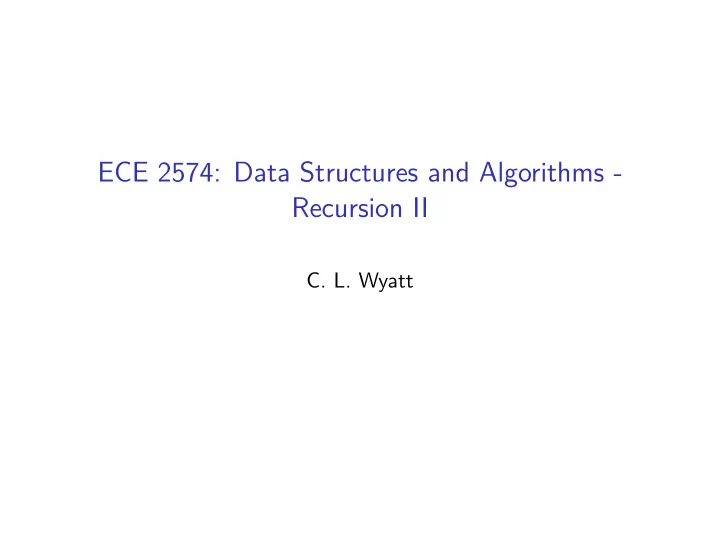

ECE 2574: Data Structures and Algorithms - Recursion II C. L. Wyatt
Today we will look at two more examples of recursion and discuss performance issues ◮ Warmup ◮ Binary search of arrays ◮ Towers of Hanoi solution ◮ Efficiency of recursion in C++
Recursion is often useful when manipulating arrays. Consider the binary search algorithm given a sorted array and a value to search for, the key. ◮ find the middle of the array ◮ if the key is in the middle slot, done ◮ if key is less, search just the lower half ◮ else search the upper half
Warmup #1 ◮ Consider the array {1,3,6,7,12,18,19} and the binary search algorithm. ◮ Assume zero-based indexing. ◮ Suppose you are searching for a key = 2. On the first call of the algorithm which index and value would you compare the key to? 69% correctly answered index 3, value 7.
A recursive version in pseudo-code function search(data[], int lo, int hi, key) returns int if(lo > hi) return -1 mid = floor( lo + (hi - lo) / 2) if (key < data[mid]) return search(data, lo, mid-1, key) elseif (key > data[mid]) return search(data, mid+1, hi, key) else return mid endfunction The first call is mid = search(data, 0, length(data)-1, key) .
A iterative version in pseudo-code function search(data[], key) returns int int lo = 0 int hi = length(data) - 1 while (lo <= hi) mid = floor( lo + (hi - lo) / 2) if (key < data[mid]) hi = mid-1 elseif (key > data[mid]) lo = mid+1 else return mid endwhile return -1 endfunction
Question, why do either of these? This implementation does not even require the array to be sorted. function search(data[], key) returns int for(int i = 0; i < length(data); ++i) if(data[i] == key) return i endfor return -1 endfunction
An important application of binary search is list filtering ◮ Credit-card numbers ◮ IP addresses ◮ Email sender filters ◮ on and on These might be setup as either whitelist or blacklist filtering.
A classic recursion example: Towers of Hanoi Move N disks from peg A to peg B, using C as an intermediary, at all times disks must be ordered largest to smallest vertically. | | | <1> | | <-2-> | | <--3--> | | =================================== A B C
Recursive Solution to Towers of Hanoi (pseudo-code) Function Towers(First, Aux, Last, n) Input: Names of three pegs: First, Aux, Last Output: solution to problem if( n == 1) write("Move disk 1 from peg" First "to Last) else Towers(First, Last, Aux, n-1) write("Move disk" n "from peg" First "to Last) Towers(Aux, First, Last, n-1) endif endfunction
Warmup #2 The recurrence relation for the number of moves when solving the towers problem for n > 0 disks, t(n) is t(n) = 2*t(n-1) + 1; with I.C. t(1) = 1 or in closed form t(n) = 2ˆn-1 How many moves does it take for n=4 disks versus n=10? 60% got this correct: 15 moves versus 1023 moves.
Number of moves required for Towers solution Number of Disks n Number of Moves t(n) ---------------------------------------- 1 1 2 3 3 7 4 15 5 31 6 63 10 1023 100 1.2677 x 10^30 ... ... ----------------------------------------
Warmup #3 What kind of recursion can be converted to a iterative algorithm? 80% correctly answered tail recursion.
Efficiency of recursion in practice ◮ many languages have much better support for recursion, e.g Haskell and Lisps ◮ we can simulate recursion using a stack (see lecture 13) ◮ In C and C++ it is hard to (portably) know how much stack you have used, but easier to track how much heap you have allocated
tail recursion A tail-recursive function is one where ◮ there is a single recursive call ◮ it is the last statement in the recursive function The simplest example for illustration int fun(int x) { if ( x == 0 ) { return x; } return fun(x - 1); } Most C++ compilers can do tail-call optimization, effectively turning into an iterative procedure, when compiled with optimization flags.
Exercise: Binary Search Lets implement the binary search algorithm operating on a std::array. 1. Download the starter code 2. In search.hpp implement the recursive binary search algorithm as defined. 3. In search.hpp implement the iterative binary search algorithm as defined. 4. Build your code locally as you work. Use the provided set of Catch tests. 5. Submit your search.hpp file via Canvas at the Assignment “Exercise for Meeting 6”.
Next Actions and Reminders ◮ Read CH 95-111 ◮ Warmup due by noon on Wednesday 9/13 ◮ Project 1 will be released by Wed. It will be due Sat 9/23.
Recommend
More recommend